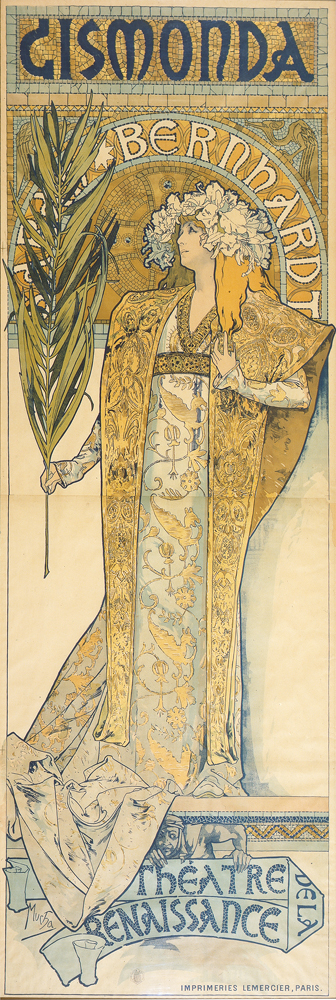
Sarah Bernhardt as Gismonda
Mucha, Alphonse Marie
1894
Artwork Information
-
Title:
Sarah Bernhardt as Gismonda
-
Artist:
Mucha, Alphonse Marie
-
Artist Bio:
Czech, 1860–1939
-
Date:
1894
-
Medium:
Color lithograph
-
Dimensions:
85 x 28 5/8 inches
-
Credit Line:
Wichita Art Museum, Gift of the Junior League of Wichita
-
Object Number:
1969.38
-
Display:
Not Currently on Display
About the Artwork
This lithographic print was created in 1895 to announce a production of the play Gismonda, which was written by Sardou and starred the French actress Sarah Bernhardt (1844-1923). Alphonse Mucha moved to Paris in 1887, attended the Académie Julian and the Académie Colarossi. Early in his career his principle means of support was through commissions to illustrate stories in journals such as Le Figaro Illustrv, La Vie Populaire and Noël Illustré. His big break came in 1894 on Christmas Eve, Mucha was at the printing firm of Lemercier proofing lithographic prints when a call came into the firm from the Théâtre de la Renaissance; Sarah Bernhardt was unhappy with the poster another artist had designed announcing her new production of Gismonda. The Theatre needed an artist to create a new poster before New Year’s Day. Mucha was at the right place, at the right time, although he had never designed a poster before.
Bernhardt was so impressed with the poster design that she signed Mucha to a six-year contract. Mucha eventually designed poster, costumes, sets and jewelry for her. Thanks mainly to the notoriety Mucha received from the poster and to his link to Bernhardt he was able to hold his first one-man show 18 months later at the Salon des Cents. He also received several other commissions, designing posters for champagne, chocolates, cigarette-papers and toothpaste, to name a few.
The Wichita Art Museum poster is seven feet in height and was printed in two sections and then joined in the middle. This poster set the standard for many of Mucha’s later designs. Mucha treated the poster architecturally. He created a pedestal on which the actress stands, an opening or doorway to frame her, and a tympanum above. The tympanum is covered with tesserae that reflect Byzantine designs. Inset into these tesserae is the title of the play and the actress’s name; the bottom base holds the name of the theatre. Mucha’s choice of color is a break from the posters being created by his contemporaries such as Toulouse-Lautrec and Chéret, who used bold vibrant colors. Mucha chose softer, more muted colors: green, brown, rose and gold.